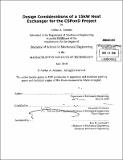| dc.contributor.advisor | Alexander H. Slocum. | en_US |
| dc.contributor.author | Adames, Adrian A | en_US |
| dc.contributor.other | Massachusetts Institute of Technology. Dept. of Mechanical Engineering. | en_US |
| dc.date.accessioned | 2010-11-08T17:41:14Z | |
| dc.date.available | 2010-11-08T17:41:14Z | |
| dc.date.issued | 2010 | en_US |
| dc.identifier.uri | http://hdl.handle.net/1721.1/59888 | |
| dc.description | Thesis (S.B.)--Massachusetts Institute of Technology, Dept. of Mechanical Engineering, 2010. | en_US |
| dc.description | "June 2010." Cataloged from PDF version of thesis. | en_US |
| dc.description | Includes bibliographical references (p. 32-33). | en_US |
| dc.description.abstract | The objective of this work was to develop a 15 kW heat exchanger model for the CSPonD molten salt receiver that will shuttle the molten salt's thermal energy for conversion to electric power. A heat extraction system comprising of an intermediate heat exchanger placed inside the molten salt receiver is proposed. Using an intermediate working fluid to shuttle heat energy between the receiver and a power cycle working fluid, thermal loads in the heat exchanger are reduced when compared to a similar alternative heat extraction system without a buffer-like intermediate working fluid. Select salt compositions were examined as intermediate working fluid candidates. The fluoride salt composition LiF-NaF-KF showed the best heat transfer performance, providing the greatest heat transfer rate per unit area relative to all the other candidate working fluids. For the LiF-NaF-KF salt composition to attain a thermal power output of 15 kW in two 0.75 in schedule XXS pipes at a flow velocity of 2 m/s, 0.053 m² of heat exchanger surface area is required. The fluoride salts examined were the easiest to prepare and use but also the most expensive salts considered. The LiF-NaF-KF salt composition was priced at $7.82/kg. A selection of high temperature alloys capable of withstanding the high operating temperatures of molten salts were chosen as candidate materials for the heat exchanger and ranked based on the allowable stress levels near the operating temperature range of the heat exchanger. Alloys Inconel 671, Inconel 625, and Haynes 230 had the highest allowable stresses at 750 °C, while the stainless steel alloys 310S and 321 have the lowest allowable stresses at 750 °C. Corrosion data for the examined molten salts and high temperature materials near the heat exchanger operating temperatures are very limited and fragmented requiring that any design decisions regarding intermediate fluid selection or materials selection be made after thorough testing is conducted. | en_US |
| dc.description.statementofresponsibility | by Adrian A. Adames. | en_US |
| dc.format.extent | 39 p. | en_US |
| dc.language.iso | eng | en_US |
| dc.publisher | Massachusetts Institute of Technology | en_US |
| dc.rights | M.I.T. theses are protected by
copyright. They may be viewed from this source for any purpose, but
reproduction or distribution in any format is prohibited without written
permission. See provided URL for inquiries about permission. | en_US |
| dc.rights.uri | http://dspace.mit.edu/handle/1721.1/7582 | en_US |
| dc.subject | Mechanical Engineering. | en_US |
| dc.title | Design considerations of a 15kW heat exchanger for the CSPonD Project | en_US |
| dc.type | Thesis | en_US |
| dc.description.degree | S.B. | en_US |
| dc.contributor.department | Massachusetts Institute of Technology. Department of Mechanical Engineering | |
| dc.identifier.oclc | 676690063 | en_US |

